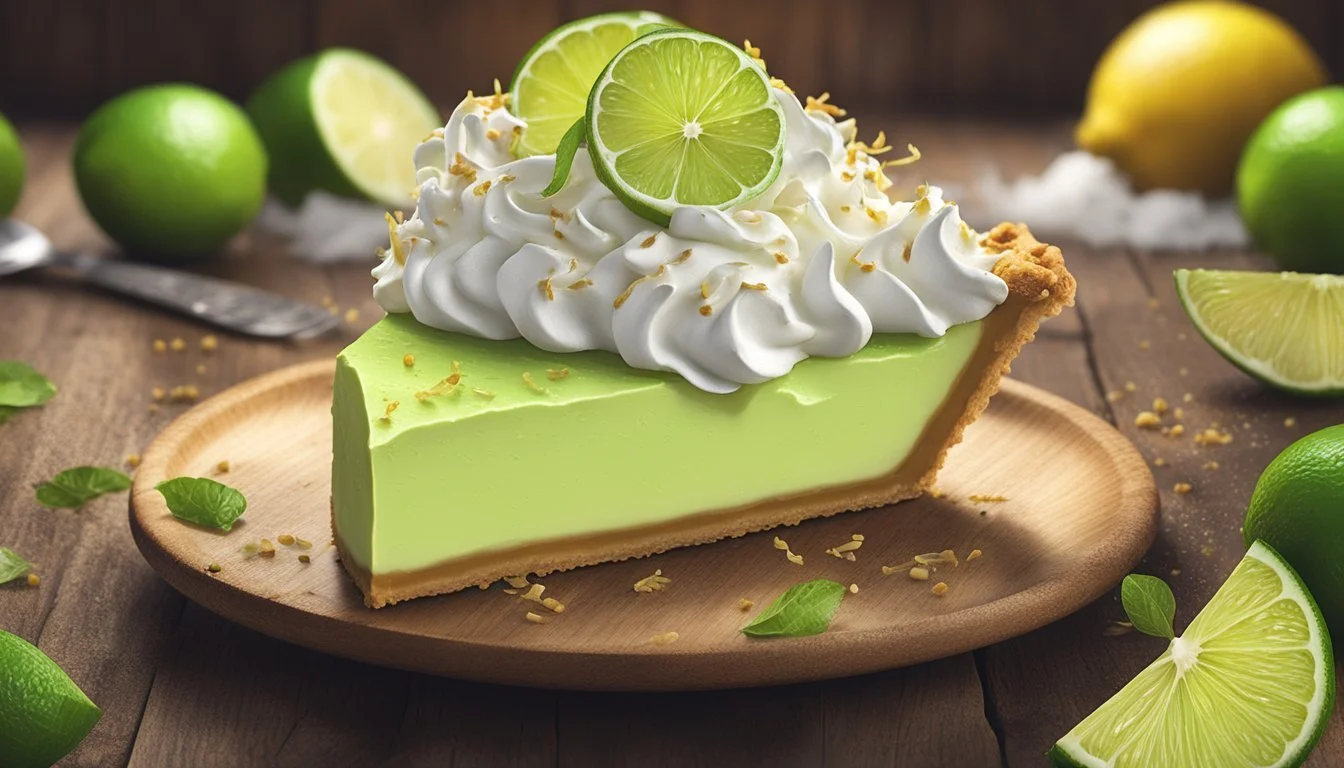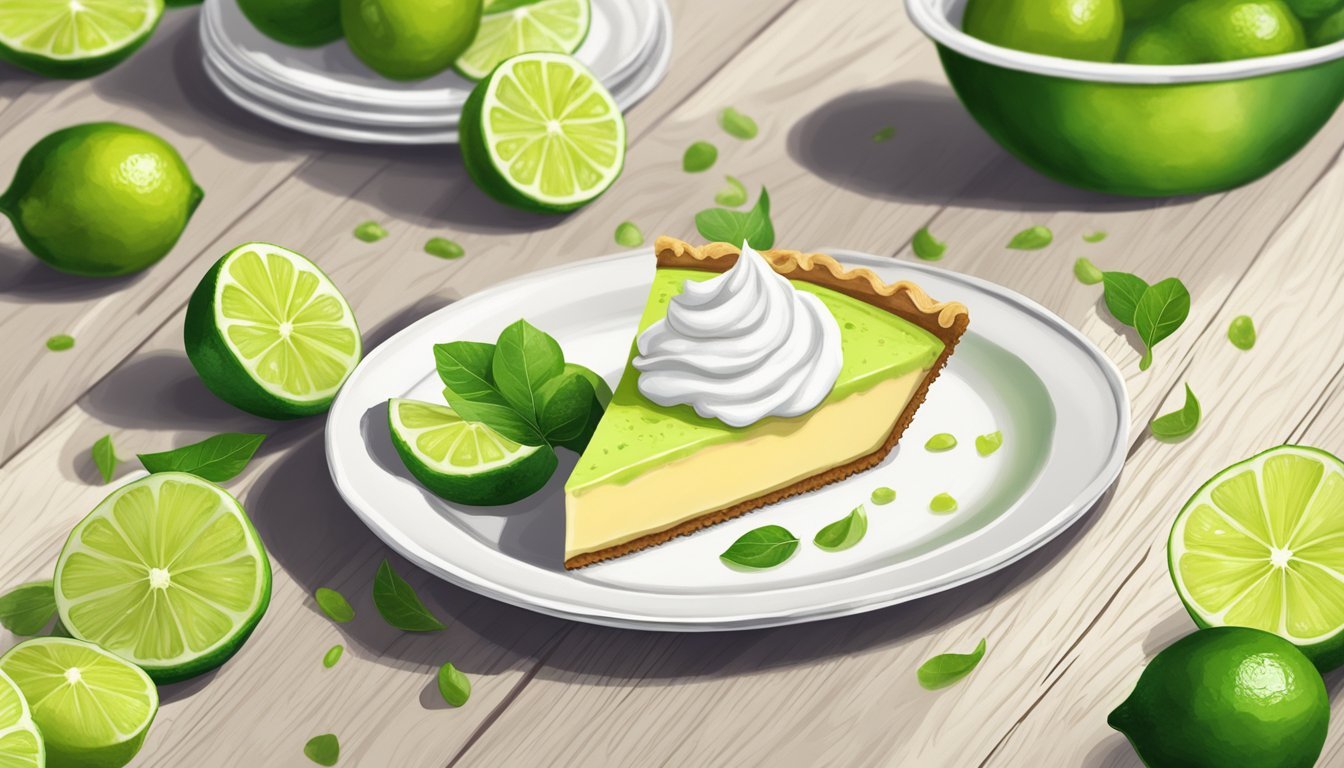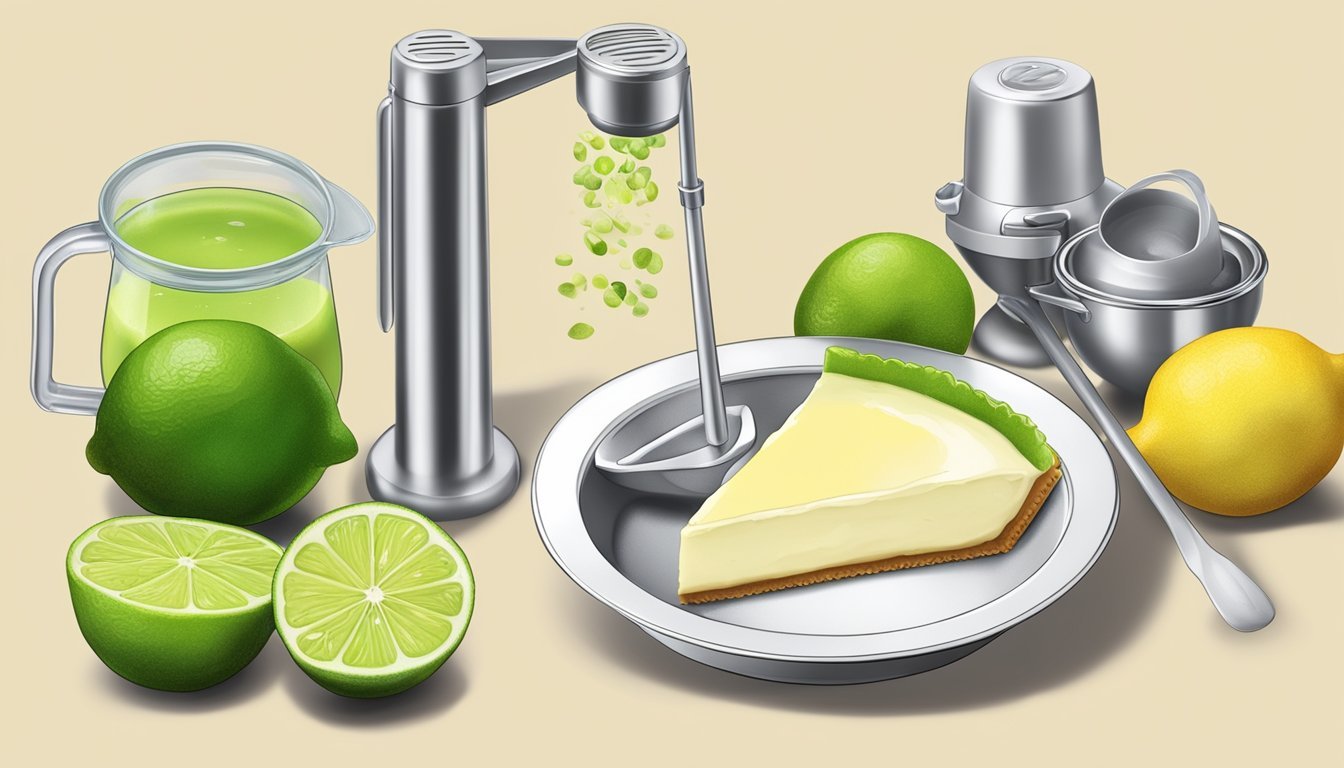Is Key Lime Pie Vegan?
Understanding Its Traditional Ingredients
Key lime pie is a classic dessert, beloved for its creamy texture and citrusy tang, but the traditional recipe is not vegan, as it typically includes ingredients such as eggs, condensed milk, and butter. However, the rise of veganism has led to an increased demand for plant-based alternatives, and as a result, there are now many ways to create a vegan key lime pie that maintains the distinctive flavor and satisfying richness of the original.
Vegan key lime pie swaps out animal products for plant-based ingredients. For example, the crust is often made from ground vegan-friendly biscuits or graham crackers mixed with vegan butter. Instead of traditional condensed milk, vegan versions might use plant-based sweetened condensed milk. The filling can be made creamy with ingredients like soaked cashews, coconut milk, or silken tofu, with key lime juice providing the characteristic zesty flavor.
Ensuring the dessert is vegan involves close attention to each component of the pie. From the base to the filling, and even the topping, alternatives such as agar-agar for gelatin in meringues or whipped coconut cream can be used. These substitutes not only achieve the desired texture and taste but also align with vegan dietary choices, proving that key lime pie can indeed be enjoyed as a vegan dessert without compromising on its classic appeal.
Understanding Veganism
Veganism extends beyond a diet; it's a lifestyle choice rejecting animal products. In the realm of desserts, ensuring items are vegan involves identifying and using ingredients that align with this ethos.
Defining Vegan Ingredients
Vegan ingredients are derived from plants, excluding all animal products. Here are key vegan replacements used in desserts:
Milk: Plant-based alternatives such as almond, soy, oat, or coconut milk.
Butter: Vegan butter, often made from oils like coconut, olive or other plant-derived fats.
Cream: Variations include coconut cream or soy-based creams that can whipped or used in desserts.
Eggs: Can be replaced with flaxseeds, chia seeds mixed with water, or commercial egg replacers.
These ingredients ensure a dessert can be classified as vegan, plant-based, dairy-free, and egg-free. Vegan desserts are cruelty-free and often considered environmentally friendly alternatives to traditional desserts.
Common Non-Vegan Ingredients in Desserts
When examining desserts for non-vegan ingredients, the following are common and must be avoided:
Dairy: Milk, butter, cream, and cheeses. These are sourced from animals and not suitable for vegans.
Eggs: Used for binding and leavening in many dessert recipes.
Gelatin: A thickener derived from animal collagen.
By being mindful of these ingredients, one can ensure the creation of a truly vegan dessert, using plant-based alternatives to traditional, animal-derived products.
The Key Lime Pie Basics
Key Lime Pie, a delightful dessert known for its distinct tart and sweet flavors, traditionally involves a creamy filling atop a crumbly pie crust, often accentuated with lime zest.
Traditional Key Lime Pie Composition
Crust:
Foundation: Graham Cracker Crumbles
Binding Agent: Butter (melted)
Filling:
Base: Sweetened Condensed Milk
Acidity: Key Lime Juice and Lime Zest
Firmness: Eggs
The quintessential key lime pie features a filling that is both tart from the lime juice and sweet due to the condensed milk, resulting in a balanced flavor profile. Eggs are incorporated to thicken the mixture and achieve a creamy texture. This filling is then poured into a pie crust, which is commonly made from crushed graham crackers mixed with butter, providing a crumbly and slightly salty contrast.
Veganization of Key Lime Pie
To adapt key lime pie for vegan diets, traditional ingredients are replaced with plant-based alternatives.
Crust:
Foundation: Graham Cracker Crumbles (vegan-friendly)
Binding Agent: Vegan Butter or Coconut Oil
Filling:
Base: Vegan Sweetened Condensed Milk (commonly coconut-based)
Acidity: Lime Juice and Lime Zest
Firmness: Cornstarch or Arrowroot as thickening agents
The transformation to a vegan key lime pie retains the iconic tart and sweet taste by using lime zest and lime juice. Vegan condensed milk, often made from coconut milk, offers the necessary sweetness and creaminess. Instead of eggs, thickeners like cornstarch are used to achieve the desired consistency of the filling. The crust remains largely the same but is made with vegan butter or coconut oil to keep it dairy-free.
Ingredients Breakdown
Crafting a vegan key lime pie requires careful selection of plant-based ingredients to mimic the iconic flavor and texture of the traditional recipe. This breakdown focuses specifically on the key ingredients needed for a vegan version of the dessert.
Selecting the Right Limes
Key limes are ideal for authentic key lime pie flavor due to their distinct, tart taste. However, if they aren't available, regular limes can be substituted, though the flavor will be mildly different. Use fresh lime juice for key lime juice to ensure a vibrant citrus flavor.
Crust Components for Vegan Key Lime Pie
Traditional key lime pie crust is made from graham crackers, which are not typically vegan due to honey content. Vegan versions of graham crackers are available and can be combined with vegan butter or coconut oil to hold the crust together. Crush the crackers into fine crumbles before mixing with the melted fat.
Filling Essentials
The filling should balance sweet and tart flavors, achieved by key lime juice or regular lime juice, and a thickening agent like starch. Options for starch include cornstarch, arrowroot, or possibly tapioca. Blended cashews or tofu can provide the creamy texture that eggs and dairy would traditionally supply.
Sweetener Choices
Vegan sweeteners such as cane sugar, coconut sugar, or maple syrup can be used to adjust the sweetness of the filling. Each sweetener will impart a different flavor profile and sweetness level, so one should opt for the preferred taste.
Vegan Dairy Alternatives
Dairy in key lime pie is usually replaced with vegan products like coconut milk, which offers a creamy texture and subtle coconut flavor. Vegan whipped cream can be made from chilled coconut milk or bought pre-made for convenience. To achieve the buttery aspect in the crust, employ vegan butter or coconut oil.
Recipe and Preparation
In this section, readers will learn specific methods to create vegan key lime pie, discover alternative recipes, and understand the essentials of baking and freezing techniques to ensure perfect consistency and flavor.
Classic Vegan Key Lime Pie Recipe
A classic vegan key lime pie recipe typically involves a blend of soaked cashews, plant-based milk, key lime juice, a thickener such as arrowroot starch or cornstarch, and a sweetener. They blend these ingredients in a high-speed blender until the mixture reaches a super smooth consistency. The crust can be made with vegan-friendly biscuit crumbles mixed with melted coconut oil, pressed into a pie dish, and baked to set. The filling is then added to the crust and baked or chilled until firm.
Alternative Vegan Recipes
For those seeking variety, numerous vegan key lime pie recipes are available, including no-bake options. One might use gluten-free graham crackers for the crust to cater to those with dietary restrictions. Alternatives to traditional fillings include vegan condensed milk, coconut cream, or avocado-based mixtures. These are combined in a food processor or blender along with lime juice and zest, sweeteners, and a pinch of salt. Diverse recipes offer options to personalize the pie to various taste preferences or dietary needs.
Baking and Freezing Techniques
Baking a vegan key lime pie requires attention to detail. The crust should be pre-baked to provide a solid base. The filled pie might need further baking to set the filling, typically around 20 minutes at 350°F (180°C). To freeze a key lime pie, ensure it cools completely before wrapping it securely to avoid freezer burn. It can be a freezable dessert suitable for advance preparation; however, no-bake recipes with high moisture content may not freeze well. When ready to serve, one should thaw the pie gradually in the refrigerator.
Presentation and Serving
When presenting and serving vegan key lime pie, the goal is to create a visually appealing dessert that tantalizes the taste buds with its refreshing flavor. The final touches with decorations and accompaniments are crucial for a delectable experience.
Decorating Vegan Key Lime Pie
The visual appeal of a vegan key lime pie can be elevated to a show-stopping dessert by focusing on simple yet elegant decorations. Vegan whipped cream can be piped around the edges of the pie to create a classic look with stiff peaks. For a splash of color and a hint of the pie's flavor, lime slices can be placed strategically on top. Additionally, a sprinkle of lime zest adds a burst of color and enhances the lime aroma. It's essential to use a 9-inch pie for ample space to showcase the decorations.
Serving Suggestions
Serving vegan key lime pie is best done by first ensuring that the pie crust is fully set and cooled to maintain structural integrity. Each slice can be plated with a dollop of coconut whipped cream on the side for a complementary texture and flavor. As the pie itself is rich and tangy, it pairs nicely with a simple cup of coffee or a glass of unsweetened iced tea. When possible, opt for eco-friendly serving ware to align with the vegan theme of the dessert.
Nutritional Information and Benefits
Traditional key lime pie is not vegan, as it typically contains non-vegan components like eggs and dairy. However, a vegan key lime pie substitutes these animal products with plant-based ingredients, offering a dessert that vegans can enjoy, as well as those with dairy and egg allergies.
A vegan key lime pie typically comprises a crumbly base made from vegan graham crackers or digestives combined with melted vegan butter or oil. The filling is primarily made from key lime juice, zest, and a variety of plant-based thickeners and sweeteners, such as cashews, tofu, agar-agar, or vegan condensed milk, often colored with natural food colorants to achieve the characteristic green hue.
Nutritional Benefits:
Plant-Based: Entirely free from animal-derived ingredients, supporting a cruelty-free diet.
Dairy-Free: No lactose or dairy, beneficial for lactose-intolerant individuals.
Egg-Free: Suitable for those with egg allergies or dietary restrictions.
Typical Nutrition Information per slice (varies by recipe):
Nutrient Amount Calories 200-300 Protein 3-5g Carbohydrates 25-35g Dietary Fiber 1-4g Sugars 15-20g Fat 10-15g Saturated Fat 3-5g Sodium 100-200mg
The plant-based nature of vegan key lime pie means it is typically cholesterol-free and can contain healthier fat sources, such as nuts or seeds. It's also a refreshing option that is enriched with the zesty flavor and vitamin C from fresh lime juice. However, portion control is advised as vegan desserts can still be high in sugars and fats. Always reviewing the ingredients used is essential for those monitoring nutritional intake closely.
Common Questions and Tips
When creating a vegan key lime pie, several questions often arise regarding ingredient replacements and storage. This section aims to provide clear, specific guidance to ensure a delicious, vegan-friendly outcome while addressing common dietary concerns.
Substitutions for Allergies and Preferences
For individuals with gluten sensitivities, swapping the traditional pie crust with a gluten-free alternative is key. This could involve using gluten-free graham crackers or cookies for the base. Those with nut allergies can opt for seeds, such as sunflower or pumpkin, in place of nuts for any crust recipe that requires them.
Vegan Butter: A staple in vegan baking, used to bind the crust or add richness.
Vegan Condensed Milk: Typically made with coconut milk, replacing dairy condensed milk to maintain creaminess.
Eggless Fillings: Ingredients like silken tofu, aquafaba, or agar powder can mimic the texture that eggs provide.
Aquafaba: The liquid from canned chickpeas which, when whipped, can replace egg whites to create a meringue-like topping.
Powdered Sugar: For a smooth sweetening agent, ensure it is organic or labeled vegan to avoid bone char processing.
For enhancing flavor without lime, lemon juice can be a close substitute, though the characteristic key lime taste will be different. When zesting citrus fruits, a microplane achieves the finest grate suitable for blending into fillings.
Storage Advice
Once your vegan key lime pie is ready, proper storage is essential to maintain its freshness.
Airtight Container: Store the pie or slices in an airtight container to keep it from absorbing other flavors from the fridge and to prolong its shelf life.
Refrigeration: Typically, a vegan key lime pie can last up to 5 days when refrigerated.
Freezing: If longer storage is needed, freezing the pie is an option. Wrap snugly to prevent freezer burn and defrost in the fridge before serving.
For best results, ensure that ingredients like silken tofu or vegan condensed milk are well-incorporated using a stand mixer for a smooth texture. If using agar powder, allow the mixture to cool slightly before pouring it into the crust to avoid separation.
Culinary Techniques and Tools
Creating a vegan version of key lime pie requires precision and the right kitchen gadgets to achieve the desired taste and texture that rival traditional recipes. The use of a food processor or blender is instrumental in preparing the crust and filling, while understanding how to manipulate vegan thickeners like cornstarch or agar powder ensures the pie sets perfectly.
Using a Food Processor or Blender
One must-have tool in the preparation of a vegan key lime pie is a food processor or a high-speed blender. These appliances play a critical role in creating a fine, even crumb for the pie's base, which is often done by pulverizing vegan graham crackers or digestives into a sandy consistency. In the process, binding agents like melted vegan butter are incorporated to form a firm crust. Here's a brief rundown:
Crust Preparation:
Add vegan graham crackers to the food processor or blender.
Process until fine crumbs form.
Combine with melted vegan butter to create a mixture resembling wet sand.
Filling Emulsification:
For a creamy filling, soaked and drained cashews are blended with key lime juice and thickeners until super smooth. The steps involve:Blend soaked cashews with liquid ingredients until no pieces remain.
Incorporate thickeners like cornstarch for a firm set.
Achieving the Perfect Consistency
A main challenge in vegan baking is replicating the consistency of dairy-based pies such as cheesecake, coconut cream pie, or banana cream pie, all of which often use eggs or gelatin as thickeners. In vegan key lime pie, the consistency can be achieved using alternatives such as cornstarch, agar powder, xanthan gum, or arrowroot starch. A precise heat application is necessary to activate their thickening properties:
Heat Treatment:
Once the filling mixture, including the chosen starch, is ready, it is slowly heated while whisking constantly. The heating process:Activates the starch or gums, thickening the filling.
Ensures no lumps form and the texture becomes silky.
Using these techniques and tools will help you craft a vegan key lime pie with an inviting texture that does not compromise on the classic flavor and creamy consistency of the beloved dessert.







